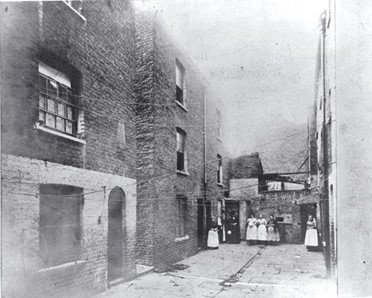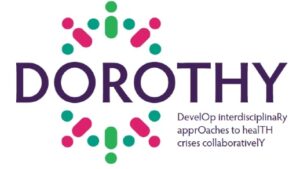Blog by Sophie Franklin
Part of the Public Health Humanities Series
And if disease is violence, and yet is within human control, is it not true that violence itself, at least, to some extent, is susceptible of being removed?
–William A. Alcott1
The question of whether violence can be eradicated like a disease may seem to be a twenty-first-century phenomenon. After all, the WHO declared violence to be a major global health burden in the late 1990s, which has led to the widespread implementation of public health approaches to violence since the early 2000s. In fact, this question has a longer history than might be supposed. US physician and educational reformer, William A. Alcott, posed it in an 1857 book titled The Laws of Health. Long before the WHO’s pronouncement on violence and health, writers were meditating on how violence was akin to a disease and framing it as a matter of public health. What might such historical understandings tell us about public health approaches to violence? And how might such findings illuminate ongoing public health initiatives seeking to reduce violence?
Arthur Morrison’s novel, A Child of the Jago, published in 1896, offers one possible answer. The novel follows Dicky Perrott, the titular child, as he navigates life in the Jago slum, modelled by Morrison on the notorious Old Nichol slum in East London. Morrison depicts the Jago neighbourhood as an unhealthy, immoral, and violent environment from which it is nearly impossible to extricate oneself. The Jago population is positioned as a risk to public health, as its inhabitants may “infect” other communities with their perceived criminality and ill-health.2 For Morrison, eugenics was the solution to such a public health risk. Dicky dies at the end of the novel, which Morrison justifies by claiming that his character “could not escape from his environment, and had he lived, would have become perforce, as bad as his surroundings,” pointing to the Jago neighbourhood’s contagiousness. In an interview following the novel’s publication, Morrison ultimately advocates for those living in slums like the Jago to be sent to “penal settlements” where they could not procreate: “Let the weed die out, and then proceed to raise the raisable.’”3

Of course Morrison’s views are extreme and do not reflect current public health approaches to violence. However, the fact that eugenics supported some earlier public health-driven attempts to reduce violence and criminality should give us pause for thought. Despite the widespread international adoption of public health approaches to violence, relatively few critical reflections on its implications and legacies have been published in recent years.
In the UK, for example, there are now twenty-one Violence Reduction Units (VRUs), which adopt a public health approach to the reduction of violence on an individual, community, and societal level. The first VRU started in Glasgow in 2005, when the city was the “murder capital of Europe,” and was implemented by Strathclyde Police.4 Although the other VRUs were also initially overseen by regional police, current initiatives bring together multiple organisations, including the police, schools, public health, community engagement centres, and many others.5
It is rare for UK VRUs to refer explicitly to violence as a contagious disease that is curable, especially in their more official documentation. Yet disease remains a powerful and influential metaphor within public health approaches to violence. The former Police and Crime Commissioner for Nottinghamshire, Caroline Henry, gave a talk in July 2023 in which she said the Violence Reduction Partnership in the region takes a public health approach to treat ‘“violence in the same way as a disease – recognising the symptoms, understanding the causes and stopping the transmission.”’6 Part of my current project on the history of viewing violence as a disease seeks to ascertain the perspectives of those working within VRUs. To what extent do police officers, social workers, public health officers, and teachers view violence as a contagious disease? And what is the impact of such a perspective?
Applying the disease model to violent behaviour poses some risks. As Kieran Mitton, a war studies researcher, writes, if “violence is understood exclusively as a disease, we risk diminishing the agency of the violent, and by extension, entirely missing the expressive or socio-economic functions of aggression.”7 And Morrison’s A Child of the Jago reveals another potential risk: public health approaches (perhaps unwittingly) reinscribing stigmas and stereotypes regarding who is deemed violent and who has the “disease” of violence. Although Alcott’s question from 1857 reminds us that violence is ultimately “within human control,” we should retain an awareness of its complexities: that perpetrators have agency and that socio-environmental factors may influence someone’s propensity for violence.8 The role of the police within initiatives like VRUs raises further questions, particularly as researchers have identified police brutality as a “public health emergency” in itself.9
I am not uncritically equating modern-day attempts to reduce societal violence with Victorian public health strategies. Yet the current iteration of public health in the UK first emerged in the nineteenth century. If a public health model is to become the dominant means of tackling societal violence, then it is worth taking stock of its history and reflecting on whether the past can teach us anything in the present—even as a lesson in what not to do.
 This project has received funding from the European Union’s Horizon 2020 research and innovation programme under the Marie Skłodowska Curie grant agreement No 101034345, as well as the Irish Research Council, the Health Research Board, the Environmental Protection Agency and Marie Skłodowska-Curie Actions as part of the DOROTHY COFUND.
This project has received funding from the European Union’s Horizon 2020 research and innovation programme under the Marie Skłodowska Curie grant agreement No 101034345, as well as the Irish Research Council, the Health Research Board, the Environmental Protection Agency and Marie Skłodowska-Curie Actions as part of the DOROTHY COFUND. 
Dr. Sophie Franklin is a DOROTHY COFUND postdoctoral researcher based at University College Dublin and the University of Reading. Her research traces the history, from the nineteenth century to the present, of representing violence as contagious.
Reference List
[1] The Laws of Health: or, Sequel to “The House I Live In” (Boston, 1857), 16, https://wellcomecollection.org/works/m3qu6jm6.
[2] Arthur Morrison, A Child of the Jago, ed. Peter Miles (Oxford: Oxford World’s Classics, 2012), 141.
[3] Arthur Morrison, “The Children of the Jago: Slum-Life at Close Quarters: A Talk with Mr Arthur Morrison,” Daily News, December 12, 1896.
[4] Gerard Seenan, “Scotland has second highest murder rate in Europe,” The Guardian, September 26, 2005, https://www.theguardian.com/uk/2005/sep/26/ukcrime.scotland.
[5] Laura Caulfield et al., “Reflections on Good Practice in Evaluating Violence Reduction Units: Experiences from across England and Wales,” Evaluation, 29, no. 3 (July 2023), 278, https://doi.org/10.1177/13563890231183993.
[6] ‘Stopping the Spread of Violence “Disease,”’ Nottinghamshire Police & Crime Commissioner, July 27, 2023 https://www.nottinghamshire.pcc.police.uk/News-and-Events/Archived-News/2023/Stopping-the-spread-of-violence-‘disease’.aspx.
[7] “Public Health and Violence,” Critical Public Health, 29, no. 2 (2019), 135. https://doi.org/10.1080/09581596.2019.1564223.
[8] Alcott, The Laws of Health, 16.
[9] Yoshiko Iwai, Zahra H. Khan, and Sayantani DasGupta, “Abolition medicine,” The Lancet 396, no. 10245 (July 2020): 159. https://doi.org/10.1016/S0140-6736(20)31566-X.